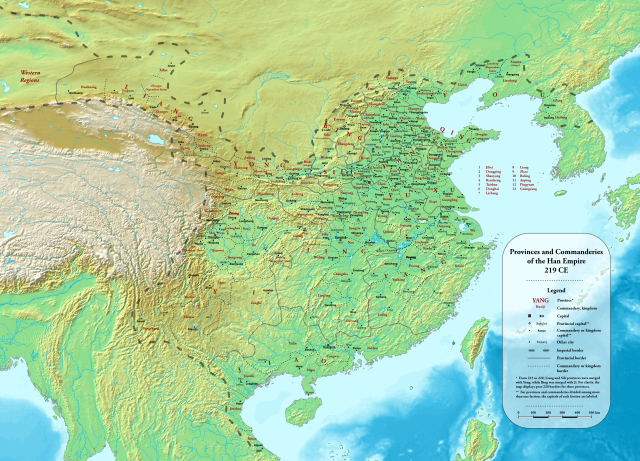Top Qs
Timeline
Chat
Perspective
List of provinces and commanderies of the Han dynasty
From Wikipedia, the free encyclopedia
Remove ads
Local governments in the Han dynasty (202 BC – 220 AD) consisted of three levels of administrative divisions: provinces (cishibu 刺史部, or zhou), commanderies (jun) and counties (xian). The early Han dynasty inherited a two-tiered system of government composed of commanderies and counties from the Warring States (5th century BC – 221 BC) and the Qin dynasty (221 BC – 206 BC),[1] while 13 provinces were created on top of the existing hierarchy in 106 BC.

In each province, the central government assigned an Inspector (cishi, 刺史) to audit the administration of commanderies and kingdoms, from 106 BC to 1 BC and from 42 AD to 188 AD. In other periods, the position was replaced by a Governor (mu, 牧, literally "shepherd"), a higher-ranked official.[2] A commandery was under a Commandery Administrator (junshou, 郡守, before 148 BC) or a Grand Administrator (taishou, 太守, after 148 BC).[3] A county was governed by a Magistrate (ling, 令, for larger counties) or a Chief (zhang, 長, for smaller counties), who were the lowest local officials directly appointed by the central government. A special type of county, known as march (dao, 道), was used to administer certain areas with "barbarian" populations, especially on the frontiers of the empire.[4]
In early Han dynasty, chief followers and relatives of the emperor were granted kingdoms. However, independence of the kings gradually diminished. After the failed Rebellion of the Seven States, drastic measures were instated to limit the power of the kings.[5] From 145 BC onward, the central government controlled the appointment of all important officials in the kingdoms. Larger kingdoms were divided, and eventually the government of a kingdom became identical to that of a commandery. For example, the Chancellor (xiang, 相) was equivalent to a Grand Administrator.[5] Similarly, marquessates were administered in the same way as counties.[6]
By the end of the Western Han dynasty, the empire had 103 kingdoms and commanderies, as well as 1,587 counties. The Eastern Han census in 140 AD documented 99 kingdoms and commanderies, and 1,179 counties.[3][4]
Remove ads
Provinces
Summarize
Perspective
There were 13 provinces in the Han Empire. The capital region, although similar to a province in size, was not assigned an Inspector, but was instead inspected by the Colonel Director of Retainers (Sili xiaowei, 司隸校尉).[2] The region was therefore often known as "Sili".
During the Western Han dynasty, the Inspectors were agents of the central government, and did not permanently reside in the provinces. The Inspectors/Governors were transferred to the local government only in 35 AD.[7]
Apart from the capital region, the 13 provinces are:
Remove ads
Commanderies
- While usually listed alongside commanderies, Jingzhao, Zuopingyi, Youfufeng were not commanderies themselves. Instead, Jingzhao was governed by the Intendant of the Capital. Zuopingyi and Youfufeng were also titles of the officials that administer the two regions. The three regions in the Guanzhong Plain, collectively known as "Sanfu" (三輔), were briefly divided into regular commanderies (Weinan, Heshang and Zhongdi) in the first years of the Former Han. From 198 BC to 104 BC, they were overseen by the Clerk of the Capital (Neishi 內史). There were two Clerks of the Capital ("left", Zuo Neishi; and "right", You Neishi) from Emperor Wen's reign onward, who were in charge of the northern and southern halves of the region, respectively.[12] Henan was administered in a similar way to Jingzhao during the Eastern Han period.
- Corrected based on commentary in 曹金华 (2014). 后汉书稽疑. p. 1511.
- Dissolved in 37 AD, reestablished in 60 AD
- Dissolved in 37 AD, reestablished in 90 AD
- Dissolved in 37 AD, reestablished in 198 AD
- A separate commandery from the first Lujiang Commandery
- Dependent States were institutions that governed non-Han peoples in the empire. Their chief officials were known as Chief Commandants (duwei, 都尉). Most Dependent States were subordinate to commanderies. However, six important Dependent States were elevated to full commandery status during Emperor An's reign.[14]
- Disputed
- Dissolved in 37 AD, reestablished in 96 AD
- Dissolved during Emperor Ling's reign, reestablished in 220 AD
Remove ads
See also
References
Wikiwand - on
Seamless Wikipedia browsing. On steroids.
Remove ads
